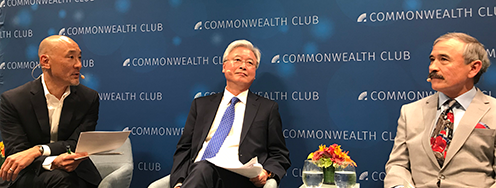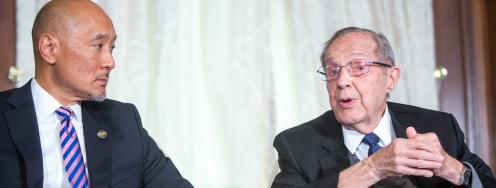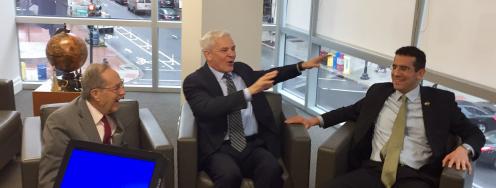Behind the Scenes: The Four Horsemen
Ever since their remarkable op-ed "A World Free of Nuclear Weapons" hit the Wall Street Journal in 2007, the world has been fascinated by the continuing efforts of five former high-profile Cold Warriors to rid the world of nuclear weapons. A new book, The Partnership: Five Cold Warriors and their Quest to Ban the Bomb, by former New York Times journalist Phil Taubman takes us behind the scenes of this remarkable group.
The story has been called 'fascinating and haunting' by the New York Times, weaving together the stories of the five men as well as the political and technological currents that have gotten nuclear weapons policy from a massive arms race to possible disarmament. Taubman gives us an inside scoop on the book in a short interview below.
Ploughshares Fund: What inspired you to write this book?
Phil Taubman: I was drawn to nuclear weapons issues by my many years as a national security reporter and editor at The New York Times. I witnessed a Soviet underground nuclear test in 1988 in Kazakhstan -- the shock wave nearly threw me to the ground. That left a lasting impression. When I returned from the Soviet Union, I made a point of visiting Los Alamos to better understand the origins of the first atom bomb, and traveled to Hiroshima to better comprehend its destructive power. When I heard about the joint effort of George Shultz, Henry Kissinger, Bill Perry, Sam Nunn and Sid Drell to reduce nuclear threats and ultimately eliminate nuclear weapons, I realized the story of how and why they joined forces across party lines might have the makings of a book that would illuminate nuclear weapons issues through the narrative of their lives and their realization that the world urgently needs to address nuclear threats.
PF: Bipartisan initiatives are pretty rare these days. What do you think enables this partnership to survive and thrive where so many others are failing?
Taubman: The book describes the internal dynamics of the partnership. The men are bound together by a common view that nuclear threats are rising, including the potential for a nuclear 9/11. Unlike many of the nation's leaders today, they understand that the national interest, in this case ensuring that nuclear dangers are reduced, outweighs party interests and the impulse to seek partisan advantage. They are a throwback to an era of greater comity and civility in Washington. Not that the five men always agree. Far from it. The path to their joint enterprise was not easy, as I describe in the book. But they have managed to sustain their effort because they all believe the cause is so important.
PF: What surprised you most while researching the book and spending time with Kissinger, Nunn, Perry, Shultz and Drell?
Taubman: How they have been able to set aside often acute disagreements that buffeted relations between some of the men during the Cold War, including Henry Kissinger's often caustic criticism of George Shultz for mismanaging relations with the Kremlin when Shultz was secretary of state during the Reagan administration. I was surprised by the halting, often circuitous process that lead to the Wall Street Journal op-ed article in January 2007 in which the men declared their common agenda and goal of eradicating nuclear weapons. They did not reach agreement on all points until very late in the game. I was also struck, looking back at their Cold War careers, how each man came to appreciate the unimaginable risks associated with maintaining the vast American and Soviet nuclear arsenals. Even as the men helped to build, manage and wield the American nuclear arsenal, they came to see the dangers of the arms race.
PF: The unusual partnership you describe was in many ways responsible for bringing the issue of nuclear weapons back to the forefront of public attention. What role does the public have to play in this quest?
Taubman: The public, by and large, does not spend much time thinking about nuclear threats. Many people think the threat of a nuclear attack against the United States ended with the collapse of the Soviet Union two decades ago. But once people become aware of current threats, especially the possibility of a nuclear 9/11, they realize the danger remains acute. The American people can, and should, press their government to do whatever it can to diminish the threat, to reduce outlandishly large nuclear arsenals and take other steps to control nuclear weapons and the materials and means to make them.
PF: So many people ask us who will replace the five cold warriors you featured in your book as the new generation of leaders. What do you think? Are they replaceable and/or do they need to be replaced?
Taubman: A new generation should step up to take the baton from the five men in the years ahead. The quintet has done a great deal to throw a floodlight on nuclear threats, to champion steps to reduce nuclear dangers and to make the goal of abolishing nuclear weapons a mainstream notion that was unanimously endorsed by the United Nations Security Council a few years ago. There is much the men can still do -- they remain remarkably energetic and active. But carrying the effort forward will require new leadership at some point. Who will take the lead is unclear today.
Hear more from Phil Taubman, as well as George Shultz, Sam Nunn and William Perry at a special event on February 23, 2012, sponsored by the Commonwealth Club of California and Ploughshares Fund. Get your tickets today.



